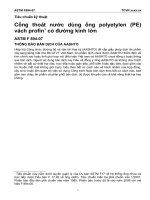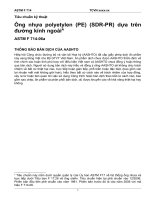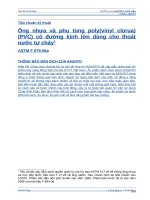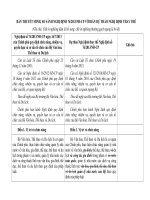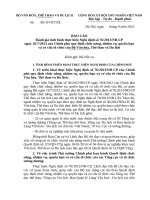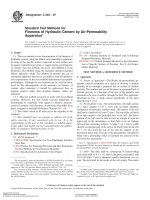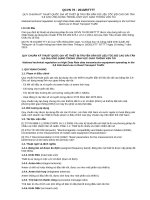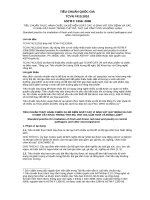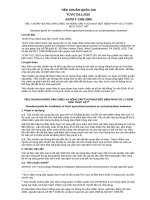Astm f 204 76 (2013)
Bạn đang xem bản rút gọn của tài liệu. Xem và tải ngay bản đầy đủ của tài liệu tại đây (50.08 KB, 2 trang )
Designation: F204 − 76 (Reapproved 2013)
Standard Test Method for
Surface Flaws in Tungsten Seal Rod and Wire1
This standard is issued under the fixed designation F204; the number immediately following the designation indicates the year of original
adoption or, in the case of revision, the year of last revision. A number in parentheses indicates the year of last reapproval. A superscript
epsilon (´) indicates an editorial change since the last revision or reapproval.
3.3 Light Source— A suitable white light source, preferably
diffuse for illumination of the bead under the microscope.
1. Scope
1.1 This test method covers the determination of the presence of surface flaws in tungsten-seal rod and wire of random
or cut lengths, and in the tungsten section of multiple-piecethrough leads used in electronic devices, by means of examination of a glass bead sealed to the tungsten.
4. Preparation of Test Specimen
4.1 The test specimen shall be a beaded tungsten rod
prepared in the following manner:
4.1.1 Clean the surface to be beaded in the usual manner
employed by the user of the tungsten.
4.1.2 Alternative Methods of Specimen Preparation—In
case of disagreement between the manufacturer and the
purchaser, substitute one of the following alternative methods
of preparing the tungsten rod for that in 4.1.1.
4.1.2.1 Boil the tungsten for 2 min in a 5 % solution of 27 %
hydrogen peroxide. Pour off the hydrogen peroxide and rinse
the tungsten twice in distilled water. Dry rapidly with pure
alcohol or in an oven heated to 100°C.
4.1.2.2 Place the tungsten in a solution (20 weight %) of
sodium hydroxide or potassium hydroxide and pass sufficient
electrical current through it to induce electrolytic action
sufficient to clean the specimen.
1.2 The values stated in SI units are to be regarded as
standard. No other units of measurement are included in this
standard.
1.3 This standard does not purport to address all of the
safety concerns, if any, associated with its use. It is the
responsibility of the user of this standard to establish appropriate safety and health practices and determine the applicability of regulatory limitations prior to use.
2. Terminology
2.1 Definitions:
2.1.1 beaded length—the actual length through which a
glass-to-tungsten seal exists as evidenced by the color of the
interface.
2.1.2 fault—a tungsten-glass seal in which a fissure, either
delineated by a line of bubbles or in itself clearly discernible,
is observed when inspected as prescribed in this test method.
2.1.3 fissure—any narrow opening or cleft in the surface of
the tungsten.
2.1.4 line of bubbles—one long or several small bubbles so
arranged in the otherwise substantially bubble-free glass bead
that they are in an almost straight line immediately adjacent to
the tungsten-glass interface.
4.2 Bead the cleaned tungsten rod over the area to be
examined with glass, of the type and wall thickness commonly
used for beading, to a length of not less than 5 mm bead length.
4.3 To permit examination of the glass-tungsten interface,
the bead shall be substantially free from bubbles, from causes
other than the tungsten defects, and shall have been so prepared
that the surface of the tungsten is clearly visible through the
bead.
4.4 The color of the glass-to-tungsten seal shall be such as
to indicate the proper application of heat to the bead to obtain
a satisfactory seal.
3. Apparatus
3.1 Beading Equipment—Suitable beading equipment capable of producing glass-to-tungsten seals as prescribed in
Section 4.
NOTE 1—The usual preferred seal color shall be a golden-yellow hue.
5. Procedure
3.2 Microscope—A low-power microscope capable of magnification up to 30 diameters, preferably of the binocular type.
5.1 Hold the beaded tungsten in focus under the microscope
in such a manner that the beaded length may be observed.
1
This test method is under the jurisdiction of ASTM Committee F01 on
Electronics and is the direct responsibility of Subcommittee F01.03 on Metallic
Materials.
Current edition approved May 1, 2013. Published May 2013. Originally
approved in 1946. Last previous edition approved in 2009 as F204 – 76 (2009).
DOI: 10.1520/F0204-76R13.
5.2 Rotate the specimen through 360° on its axis so that the
entire surface of the tungsten-glass interface may be examined.
5.3 Observe whether fissures or lines of bubbles are present
in the seal. If either are present, record the seal as a fault.
Copyright © ASTM International, 100 Barr Harbor Drive, PO Box C700, West Conshohocken, PA 19428-2959. United States
1
F204 − 76 (2013)
6. Report
6.1.6
6.1.7
6.1.8
6.1.9
6.1 Report the following information:
6.1.1 Purchase order number,
6.1.2 Diameter of specimens,
6.1.3 Number of specimens examined,
6.1.4 Magnification used,
6.1.5 Cleaning procedure used,
Type and nominal wall thickness of glass bead used.
Nominal beaded length,
Color of seal, and
Number of faults observed.
7. Keywords
7.1 glass bead; glass-to-metal seals; tungsten-glass seals
ASTM International takes no position respecting the validity of any patent rights asserted in connection with any item mentioned
in this standard. Users of this standard are expressly advised that determination of the validity of any such patent rights, and the risk
of infringement of such rights, are entirely their own responsibility.
This standard is subject to revision at any time by the responsible technical committee and must be reviewed every five years and
if not revised, either reapproved or withdrawn. Your comments are invited either for revision of this standard or for additional standards
and should be addressed to ASTM International Headquarters. Your comments will receive careful consideration at a meeting of the
responsible technical committee, which you may attend. If you feel that your comments have not received a fair hearing you should
make your views known to the ASTM Committee on Standards, at the address shown below.
This standard is copyrighted by ASTM International, 100 Barr Harbor Drive, PO Box C700, West Conshohocken, PA 19428-2959,
United States. Individual reprints (single or multiple copies) of this standard may be obtained by contacting ASTM at the above
address or at 610-832-9585 (phone), 610-832-9555 (fax), or (e-mail); or through the ASTM website
(www.astm.org). Permission rights to photocopy the standard may also be secured from the ASTM website (www.astm.org/
COPYRIGHT/).
2
